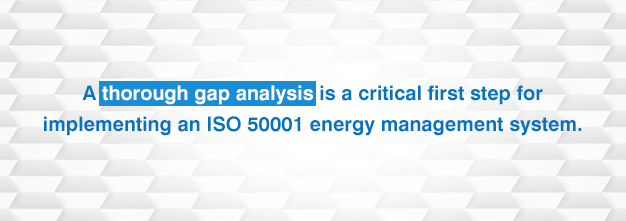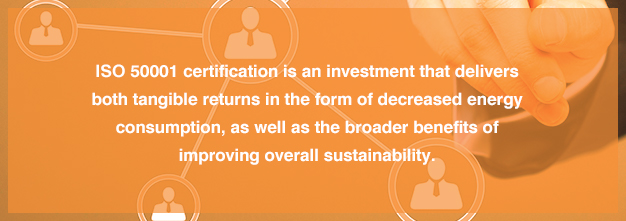Energy Management And ISO 50001

ISO 50001 is one of the more frequently misunderstood standards in the ISO family. Because it addresses energy management, there is some overlap between ISO 50001 and ISO 14001, which adds to the confusion. However, while both standards deal broadly with sustainability, each has distinct benefits. Organizations that achieve compliance with ISO 50001 will be well-positioned to run a leaner, more forward-thinking operation, one that meets current and future regulatory challenges with a minimal amount of hassle and expense.
In the following article, we cover the basics of this increasingly important management standard and look at how two organizations have used it to their benefit.
What Is Energy Management?
Energy management involves controlling consumption, increasing operational efficiency and lowering an organization’s overall environmental impact. An energy management system comprises the set of processes, metrics and individual responsibilities that help fulfill these goals.
Public and private organizations in every sector have successfully developed and implemented energy management policies. Formal management systems should be global in scope, and based on recognized best practices that cover all aspects of power consumption and monitoring.
What Is ISO 50001?
ISO 50001 is the International Organization for Standardization’s energy management standard. It was published in 2011 with participation from all member countries, as well as the U.S. Department of Energy, World Energy Council (WEC) and United Nations Industrial Development Organization (UNIDO). Like all ISO standards, it stresses repeatable, scalable processes, and continuous improvement based on the Plan-Do-Check-Act (PDCA) cycle.


ISO 50001 was designed to apply to organizations of any size, in any industry. Commercial, industrial and government operations around the world use it to:
-
Monitor, document and report energy consumption
-
Set and achieve targets for usage reduction
-
Assess, design and procure equipment, systems and processes that positively impact energy use
-
Continually review and improve energy management plans
-
Identify and manage external risk factors
-
Develop protocols for responding to emergencies
Ultimately, ISO 50001 builds more sustainable organizations from the ground up, engaging executive-level participation and codifying energy management as a key business goal.
How Is ISO 50001 Different From ISO 14001?
ISO 14001 and ISO 50001 differ primarily in scope. ISO 14001 provides a broad framework for understanding an organization’s environmental impact. ISO 50001, on the other hand, specifically addresses energy consumption and defines concrete sustainability goals. Whereas ISO 14001 emphasizes qualitative processes, ISO 50001 is more numbers-driven.
ISO 50001 can be thought of as either a standalone system or as a complement to ISO 14001. There is no requirement that businesses must be compliant with ISO 14001 before pursuing ISO 50001. However, the standards do share some common elements. A thorough gap analysis is a critical first step for implementing an ISO 50001 energy management system.


Why Is Energy Management Important?
Whether or not you are currently ISO 14001 registered, there are multiple reasons for making energy management a priority. Businesses with an ISO 50001-compliant energy management system:
-
Save money. Energy use is a major overhead expense, particularly for large or multisite businesses. Any improvements you make in overall efficiency contribute to your bottom line and profitability. Also, reducing your reliance on fossil fuels provides insulation from fluctuations in the price of oil and gas, helping you budget with greater accuracy and confidence.
-
Simplify regulatory compliance. U.K.-based organizations can avoid costly, time-consuming ESOS assessments by becoming ISO 50001 certified. In general, the improved situational awareness ISO 50001 offers makes any form of energy auditing simpler and more accurate, thus positioning your organization to move into new markets and meet new benchmarks with ease.
-
Streamline their operations. A more sustainable operation should be more streamlined, too. Wasteful systems and processes are prone to error and failure. Running a leaner business reduces those risks and helps improve your overall productivity. In a well-designed system, the additional reporting requirements of ISO 50001 will be easy to administer, saving you time and money in the long run.
-
Improve their corporate image. Consumers want to do business with forward-thinking companies. ISO 50001 is a valuable marketing tool that demonstrates sustainability is an important priority for your organization. Because of its international scope, it’s also useful for growing your business and expanding into new territory where your existing brand may not be as strong.
Ultimately, ISO 50001 certification is an investment that delivers both tangible returns in the form of decreased energy consumption, as well as the broader benefits of improving overall sustainability.


ISO 50001 In Action: Two Case Studies
-
Costa Coffee: In 2011, Costa Coffee — the largest coffee chain in the U.K. — became the first NQA client in the food industry to achieve ISO 50001 certification. A need to reduce costs and expand production without moving to a larger site was the primary motivator for this decision. Prior to certification, the company's bean roasting facility required significant amounts of power to meet its production goals. As a result, energy management became the key to achieving growth.
The certification process began with a detailed energy audit, which looked at every piece of equipment and its role in the manufacturing process. From there, the company was able to implement efficiencies that reduced its overall energy consumption by 16 percent. The results were so successful that Costa’s parent company, Whitbread, now plans to implement ISO 50001 certification in all its subsidiaries.
-
The Royal Mint: As one of the world’s largest coin producers, The Royal Mint consumes massive amounts of energy every year. In 2011 alone, electric bills for the organization’s main facilities totaled £3.7 million. Having already achieved ISO 14001 registration, The Royal Mint was in search of management standards that would focus specifically on keeping these costs down in the future.
By making energy conservation a key goal and improving communication between senior staff, the Mint was able to reduce its energy use by 6 percent in 2011 and establish formal targets for improvement in future years. On a cultural level, the certification process was highly effective at engaging employees around energy management. Regular reviews now give team members an opportunity to make suggestions for further improvements, while highlighting and rewarding those who go out of their way to be sustainability leaders.
Getting Started With ISO 50001 Certification


Keep browsing the NQA website and blog to learn more about ISO 50001 certification. Alternately, contact a representative for details about the role we can play in the process.
